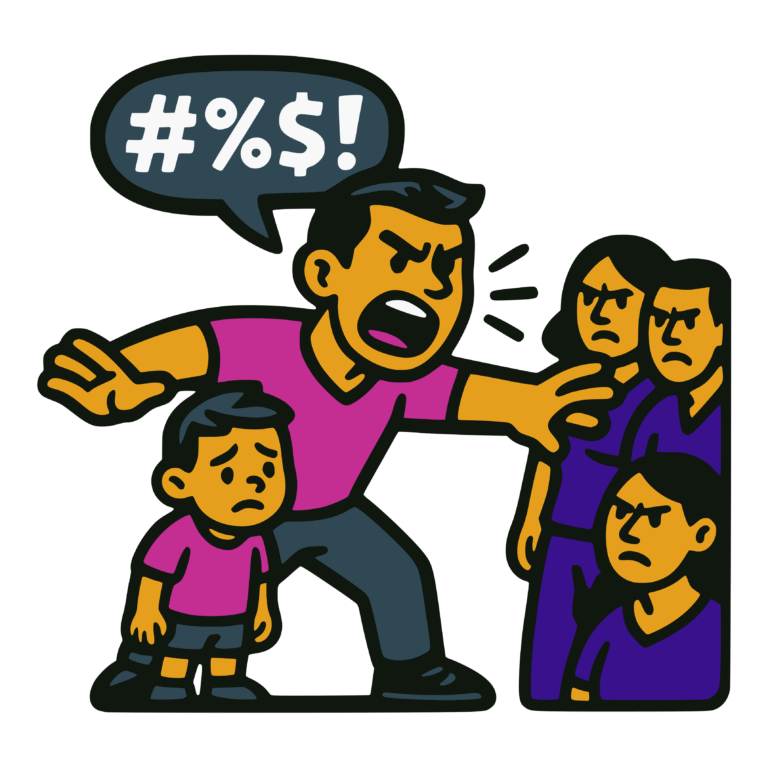Forgiveness is one of those words that sounds simple until you try to do it. In modern English, it’s become a hazy, catch-all term—cloudy enough that Christians sometimes pressure one another into “forgiving” in ways the Bible never asks for and that no human could reasonably perform. That confusion breeds discouragement: people attempt an impossible task, fail, and then feel guilty for failing.

This article aims to clear the fog. I’ll sketch what forgiveness is not, then define what it is in concrete, workable terms—anchored with Scripture and shaped for real life. I’ll also look at why forgiveness is a process rather than a one-and-done event, why it doesn’t equal reconciliation, how it coexists with legal justice and safety measures, and why all of this matters for our relationship with God and our own healing.
(I developed my thoughts on this topic by the help of multiple conversations with Garry Kiker, MS, LCMHC)
What Forgiveness Is Not
Before building, I need to demolish a few misconceptions. Biblically and practically, forgiveness is not:

- A mystical feeling or indescribable emotion. You don’t “feel” forgiveness into existence; you do forgiveness.
- Minimizing, excusing, or condoning evil. Forgiveness never calls wrong “not wrong.”
- Forgetting. “Forgive and forget” is a cultural slogan, not a bibilical command. Scripture often calls us to remember wisely.
- Automatic reconciliation. Reconciliation is a relational restoration requiring mutual trust and safety; forgiveness doesn’t magically rebuild that.
- Dependent on the other person’s repentance, confession, or remorse. Forgiveness is commanded as your obedience to God (more below).
- Conditional or limited in frequency. Jesus rejects numerical caps (Matthew 18:21–22).
- A form of justice or mercy. Those are distinct biblical categories. Forgiveness releases your claim; God remains the just Judge.
- An attempt to change the other person. It’s not leverage or a behavior-modification tool.
- A reinstatement of trust. Trust is earned and rebuilt over time; forgiveness can’t shortcut that.
If that list surprises you, you’re not alone. Many common exhortations to “just forgive” smuggle in ideas Scripture never requires—turning a simple act into an impossible knot.
What Forgiveness Is
A biblical definition of forgiveness: “Forgiveness is a spiritual act of obedience: the conscious, continual decision to release your personal claim to collect a debt for the wrong done, and to entrust judgment to God, refusing retaliation both externally and internally.”
Let’s unpack it:
- Immediate obedience. Forgiveness begins as soon as a wrong occurs. Jesus ties it to ordinary prayer: “And whenever you stand praying, if you have anything against anyone…” (Mark 11:25). You don’t wait to feel better; you obey by releasing your claim to payback.
- Full recognition of the wrong. Paradoxically, biblical forgiveness starts by telling the truth. You honestly name the injury—not downplaying it. This is vital: you can’t release a debt you won’t acknowledge.
- No retaliation—externally or internally. Forgiveness includes a commitment to refuse revenge in the hands and refuse recapitulation in the heart. That means no vengeance, but also no slow-burn versions of vengeance—resentment, passive aggression, contempt, or mental rehearsal of the offense to savor superiority or stoke rage. Paul is blunt: “Beloved, do not avenge yourselves, but rather give place to wrath; for it is written, ‘Vengeance is Mine, I will repay,’ says the Lord,” (Romans 12:19).
- Entrusting judgment to God. Jesus modeled this: “When He was reviled, did not revile in return; when He suffered, He did not threaten, but committed Himself to Him who judges righteously” (1 Peter 2:23). Forgiveness yields the gavel to the only One who knows all the facts and motives.
- Continual reaffirmation. Because wounds ache as they heal, forgiveness often needs to be reaffirmed whenever the pain resurfaces. This doesn’t mean your initial forgiveness “didn’t work.” It means you are redressing the wound and keeping the bandage clean while the deeper tissues knit.
How Wounds Heal
I believe most of us intuitively understand how physical wounds heal. If you scrape your thigh on bramble while hiking, washing and dressing the wound doesn’t instantly regenerate skin. You are responsible for cleaning, dressing, and seeking expert care when needed—but you are not in charge of knitting collagen fibers and rebuilding tissue. God designed hidden processes, and time cooperates with them.

Emotional and relational wounds are similar. You can’t command your limbic system to “heal by tomorrow.” But you are responsible for the kind of care that permits healing: naming the injury, refusing reinjury (retaliation or rumination), seeking help, and redressing the wound as needed. Forgiveness is this ongoing care—the faithful upkeep that keeps infection (bitterness, contempt, cynicism) from spreading.
Scripture warns against that infection: “Looking carefully… lest any root of bitterness springing up cause trouble,” (Hebrews 12:15). Forgiveness is how we disinfect the cut. Time and God’s grace do the knitting; our job is to keep the wound clean.
Forgiveness and the Law of the Land
Because forgiveness is a spiritual act, some assume it means letting legal consequences slide or avoiding practical safety measures. That is not biblical.
Governing authorities are God’s servants for justice.
“[The governing authority] is God’s minister to you for good. But if you do evil, be afraid; for he does not bear the sword in vain; for he is God’s minister, an avenger to execute wrath on him who practices evil.” —Romans 13:4
Reporting crimes, cooperating with investigations, and seeking restraining orders where appropriate are not betrayals of forgiveness; they are part of honoring God’s design for public justice and protection of the vulnerable.
Church community includes separation when necessary.
Jesus’ process in Matthew 18 includes escalating interpersonal confrontation and, if unrepentance persists, treating the person “as a Gentile and a tax collector” (Matthew 18:17)—a category that implies clear boundaries and relational distancing. Paul likewise commands the Corinthian church to “put away from [themselves] the evil person,” (1 Corinthians 5:13). Those actions uphold community safety and integrity.
Consequences can remain even when forgiveness is granted.
Think of David: God put away his sin (2 Samuel 12:13), yet serious consequences endured. In the same way, a Christian may forgive a sexual abuser and testify in court. The offender should be jailed and separated from the vulnerable. Forgiveness does not hide crimes under the rug or shield predators from accountability.
Forgiveness can occur simultaneously with a legal conviction or verdict. It is perfectly consistent to say, “I release my personal claim to vengeance and entrust judgment to God,” while also insisting, “The law must do its work, and safety must be protected.” Forgiveness addresses the spiritual and emotional domain; legal, relational, and practical safety domains still require wise, decisive action.
Releasing Debt
From the Torah forward, Scripture uses concrete, economic imagery for sin and release. In the Old Testament, God commands periodic debt release (Deut 15; Lev 25). Two Hebrew verbs often tied to forgiveness are ‹ נשׂא › (“nāśā’“—“to lift, carry away”) and ‹ סלח › (“sālaḥ“—God’s gracious “pardon”). In the New Testament, the common word for “forgive” is ‹ ἀφίημι › (“aphiēmi“), meaning to send away, release, let go—and it’s explicitly used of monetary debt.
Jesus teaches us to pray, “forgive us our debts, as we forgive our debtors,” (Matt 6:12). That’s not accidental vocabulary. Whether the “debt” is money, slander, betrayal, or abandonment, forgiveness is the conscious choice not to collect.
This is why forgiveness doesn’t minimize wrong: you only forgive real debts.
The Unforgiving Servant (Matthew 18:21–35)
Peter asks for a limit (“As many as seven times?”) and Jesus blasts the ceiling: “I do not say to you, up to seven times, but up to seventy times seven.” (vv. 21–22).
He then tells of a servant who owed the king 10,000 talents—an astronomical debt. A talent was a unit of weight, commonly applied to precious metals. At roughly 34 kg (75 lb) per talent and using a contemporary gold price around $60 per gram, a single talent (~34,000 g) is about $2 million. 10,000 talents? On the order of $20+ billion—an intentionally absurd, unpayable sum.

That servant is forgiven. But he throttles a fellow servant who owes him 100 denarii. A denarius was about a day’s wage for a common laborer or soldier. Using the U.S. federal minimum wage ($7.25/hour) for an eight-hour day (~$58), 100 denarii comes to roughly $5,800. That’s not trivial. Most people would feel the loss. But compared to $20 billion, it’s pocket lint.
The king heard of the hypocrisy and “delivered him to the torturers until he should pay all that was due to him,” (Matt 18:34). Jesus concludes with a warning that should make us swallow hard:
So My heavenly Father also will do to you if each of you, from his heart,
Matthew 18:35
does not forgive his brother his trespasses.
Two takeaways are essential:
- God treats our forgiveness of others as the expected overflow of the forgiveness we’ve received (cf. Eph 4:32; Col 3:13).
- The cost of unforgiveness is severe—not only relationally and emotionally but spiritually.
The Promises—and the Stakes
Jesus ties our vertical experience of God’s forgiveness to our horizontal practice of forgiving others:
- “For if you forgive others their trespasses, your heavenly Father will also forgive you, but if you do not forgive others… neither will your Father forgive your trespasses” (Matthew 6:14–15).
- “Whenever you stand praying, forgive… so that your Father also who is in heaven may forgive you your trespasses” (Mark 11:25).
- “Be kind to one another, tenderhearted, forgiving one another, as God in Christ forgave you” (Ephesians 4:32).
- “As the Lord has forgiven you, so you also must forgive” (Colossians 3:13).
This isn’t about earning grace; it’s about mirroring grace. Refusing to forgive is like clamping a tourniquet on your own heart. You starve your life with God and poison your inner life with bitterness.
Forgiveness also empowers reconciliation—without equaling it. By releasing your personal claim to repayment, you clear the first path back toward relationship if the other party pursues repentance, repair, and trust-building. But even if reconciliation isn’t wise or possible (because of safety, persistent unrepentance, or changed circumstances), forgiveness is still crucial for your healing. Otherwise, the wound festers long after the person has left your life.
“Does Forgiveness Require Their Repentance?”
No—not for the act of forgiveness as Scripture commands it. Jesus commands unconditional readiness to forgive (“seventy times seven,” Matthew 18:22) and ties it to prayer regardless of the offender’s posture (Mark 11:25). Some passages, like Luke 17:3–4, describe a process of relational restoration (“if he repents, forgive him”), which concerns reconciliation and fellowship. That’s the point: forgiveness (your release of claim and entrusting of judgment to God) is your obedience. Reconciliation (restored trust, renewed relationship) is a two-person project that requires repentance, repair, and time.
A Practical Model: How to Forgive Faithfully
To help you evaluate whether you’re actually engaging in biblical forgiveness, here’s a clear, workable sequence:
- Acknowledge a wrong has been done. This is the easiest step and the crucial start. You don’t need full comprehension yet; you simply refuse denial. “This was wrong.”
- Discern the full extent of the wrong—over time. Often we only perceive the tip of the wound at first. As days or weeks pass, you may notice deeper layers of harm. Use prayer, journaling, and conversation with a safe, trustworthy third party (a mature pastor, spouse, or licensed counselor) to surface what’s real. This is not a license for gossip; it’s triage and treatment—focused on your own thoughts, feelings, and experiences, not others’ character.
- Commit to no retaliation—externally or internally. In your actions and in your imagination: no payback, no passive aggression, no contempt, no simmering resentment, no mental replay to “win” the argument that didn’t happen. This is where the rubber meets Romans 12:19 and 1 Peter 2:23. You explicitly say, “I release my claim; I will not make you pay.”
- Entrust judgment to God. Out loud if you can. “Father, you judge justly. You saw it all. I place this case in your hands.” This step honors God’s knowledge and justice and liberates your soul from trying to run the cosmic courtroom.
- Upkeep: reaffirm forgiveness whenever the pain resurfaces. Treat it like redressing a wound. New experiences may trigger old aches. When they do, re-affirm your original commitment: “God I have forgiven; I still refuse retaliation; I still entrust this to You.” That’s not failure—it’s faithfulness.
(Keep key texts near at hand as you practice: Matthew 6:12, 14–15; Matthew 18:21–35; Mark 11:25; Romans 12:19; 1 Peter 2:23; Ephesians 4:32; Colossians 3:13; Micah 7:18–19; Psalm 103:12; Hebrews 12:15)
Why This Definition Matters
- It’s doable. We are not commanded to feel a feeling on demand or to fabricate instant trust. We are called to make a decision we can make—and to keep making it as needed.
- It clarifies boundaries. We can forgive without reconciling where trust and safety are absent. We can forgive without pretending the wrong was small. We can forgive without taking on God’s job.
- It heals you. Unforgiveness toxifies our inner world. Forgiveness is how we clean the wound and keep it clean so that God’s deep processes can do their quiet work.
- It honors God. Forgiveness is devotion: we surrender the gavel and magnify God in Jesus’ cross. “As God in Christ forgave you” becomes the pattern and power for our obedience.
Clear Eyes, Clean Hands, Clement Heart

If you’ve tried to forgive and felt like you failed because the pain returned, take heart. Pain returning is normal and doesn’t nullify forgiveness any more than a scab itching means the first bandage “didn’t work.” Return to the steps:
- name the wrong again,
- notice the new layers,
- refuse retaliation—inside and out,
- hand it back to the Judge,
- redress the wound as often as it needs.
Do this today; do it “seventy times seven” if necessary. Keep your eyes clear (about the wrong), your hands clean (from retaliation), and your heart clement (before God). As you practice this obedient release, you’ll find that forgiveness does what Scripture says it should: it aligns you with God’s heart, frees you from bitter bondage, and makes space for whatever reconciling grace God might write next.
And be kind to one another, tenderhearted, forgiving one another,
Ephesians 4:32
even as God in Christ forgave you.
(All scripture quotations are from the New King James Version of the Bible.)


